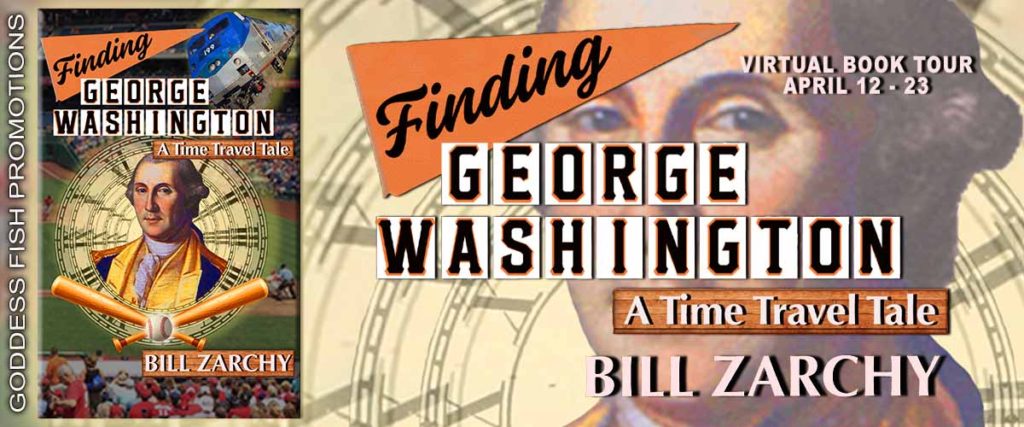FINDING GEORGE WASHINGTON by Bill Zarchy – get a behind the scenes look and enter the giveaway

Time Travel in Finding George Washington
Several years ago, as I was still developing the themes and story arc of Finding George Washington, I had lunch with a friend and told him the plot of my debut novel.
He listened to my description of the story, which starts with General Washington disappearing from the winter encampment at Valley Forge on a cold night in 1778, only to turn up at a dog park on San Francisco Bay in the summer of 2014.
“That’s not a typical time travel story,” said my friend. “Usually, people in the present are sending someone into the past, in order to change what’s already happened.”
It’s not atypical for time travel yarns to speculate about alternative realities or universes, to ask “what-if” questions and present possible answers. And that’s certainly the case here.
But in Finding George, Washington is propelled into the present, or the near present, and the drama of the story centers on the consequences of his absence from the American Revolution. This conceit does bend the rules a bit, but on the other hand … what rules? What laws of the space-time-continuum can be bent by a “scientific” concept that so far seems only grounded in fiction?
In his Theories of Relativity, Einstein speculated that time travel might be possible for an object of near-infinite mass traveling at or near the speed of light. But an object of near-infinite mass is nothing but a theoretical construct at this point in our scientific development, and speeds that fast are not attainable for “solid” objects.
“Don’t try to explain how your time travel works,” another writer admonished me. “People will just pick apart your science. Instead, focus on how it’s used and what it does.” This was great advice. I didn’t have to invent phony scientific concepts to explain time travel. I spent most of a chapter or two cobbling together a funky device to make it all happen, but I left the quantum physics and temporal displacement theories to someone else.
A professor of astronomy wrote to me recently about my book. “Of course, I’m going to argue that such a tale is impossible in reality, but I also very much enjoy such tales anyway and think time travel is a good literary device.” He openly acknowledges that there may be no place for time travel in real science, but he enjoys stories that use the concept for dramatic storytelling.
In many time travel tales, a change in the past often leads to momentous — and immediate — consequences in the present. With some exceptions. In the Back to the Future movies, Marty McFly, the Michael J. Fox character, goes back in time and learns that his very existence depends on his future parents meeting and falling in love while in high school. Marty has to go through often-hilarious machinations to make sure this happens. At several points, when events seem to be conspiring to prevent his folks from meeting, Marty notices that his own image in a precious family photograph has begun to fade. When the parents do get together, his image becomes clearer, less vague.
I loved this idea, that the consequences of changes in the past might not be sudden and immediate, but gradual and incremental. I enjoyed creating a world in transition. Washington’s absence from the past causes a slow pattern of change from the world his new friends in 2014 can still remember, devolving to an impoverished colonial backwater they would rather forget.
One more thing I had to deal with: does time travel necessarily also include geographical displacement? In Dickens’ A Christmas Carol, Ebenezer Scrooge goes backward and forward in time with the Ghosts of Christmas Past and Future — at a variety of different locales in Victorian London. In H.G. Wells’ The Time Machine, the eponymous device moves its occupants through time and space. In A Connecticut Yankee in King Arthur’s Court by Mark Twain, Hank Morgan suffers a bump on the head and wakes up in King Arthur’s England in the 5th Century. But in the contemporary novel The Time Traveler’s Wife, by Audrey Niffenegger, Henry, the protagonist, travels through time and space, often randomly, and always without his clothes.
In the world of Finding George, the temporal displacement device, a time machine, has the capability to move people through time, but not space. So I still had to find a plausible way to get George from Valley Forge to California. Did I succeed? Check it out.

Finding George Washington
by Bill Zarchy
GENRE: Historical-Time Travel-Baseball Thriller
BLURB:
On a freezing night in 1778, General George Washington vanishes. Walking away from the Valley Forge encampment, he takes a fall and is knocked unconscious, only to reappear at a dog park on San Francisco Bay—in the summer of 2014.
Washington befriends two Berkeley twenty-somethings who help him cope with the astonishing—and often comical—surprises of the twenty-first century.
Washington’s absence from Valley Forge, however, is not without serious consequences. As the world rapidly devolves around them—and their beloved Giants fight to salvage a disappointing season—George, Tim, and Matt are catapulted on a race across America to find a way to get George back to 1778.
Equal parts time travel tale, thriller, and baseball saga, Finding George Washington is a gripping, humorous, and entertaining look at what happens when past and present collide in the 9th inning, with the bases loaded and no one warming up in the bullpen.
Excerpt:
I had once kissed my old girlfriend Marnie on the Kiss Cam, a few months after we started dating, when things were still going well between us. I didn’t miss her, exactly. She had treated me badly. But the memory brought on pangs of loneliness. The camera focused on a young couple in the stands, who watched as their image came up on screen, then dove into a passionate smooch.
The crowd cheered. Though he still wasn’t sure what was happening, George was shocked by these indecorous public displays of affection. The camera cut to an older couple, who responded with a much more dignified buss. Light booing and laughter from the masses.
Sinatra continued to croon to “Strangers in the Night.” George was mortified.
“Timothy, this song and these people seem to be celebrating romantic liaisons of the most crude and casual type. How offensive!”
The screen cut to a pimply young guy, who practically leaped onto his cute girlfriend, attacking with a scary abundance of tongue.
“Ewww,” a girl behind us called out. Our whole section laughed.
The image on screen switched to George, with Rachel beside him. In that strong left profile shot, with his pale skin, high forehead, prominent apple cheeks, graying russet hair tied in back, and aquiline nose, he looked just like the guy on the quarter dollar.
The camera seemed to stay on them forever. Finally, with a good-natured grin, Rachel gave him a prim peck on the lips, then lingered an extra second or two. The fans screamed their appreciation.
I was speechless, overcome with dread, though not sure why. How had this happened? We had brought the Father of Our Country out in public to a baseball game in San Francisco.
And his iconic face was up on a giant screen, being kissed by a woman not his wife, as Sinatra sang about getting lucky.
I shared the moment with 40,000 of my closest friends at the ballpark. I hoped all their intentions were friendly.
AUTHOR Bio and Links:
Bill Zarchy filmed projects on six continents during his 40 years as a cinematographer, captured in his first book, Showdown at Shinagawa: Tales of Filming from Bombay to Brazil. Now he writes novels, takes photos, and talks of many things.
Bill’s career includes filming three former presidents for the Emmy-winning West Wing Documentary Special, the Grammy-winning Please Hammer Don’t Hurt ‘Em, feature films Conceiving Ada and Read You Like A Book, PBS science series Closer to Truth, musical performances as diverse as the Grateful Dead, Weird Al Yankovic, and Wagner’s Ring Cycle, and countless high-end projects for technology and medical companies.
His tales from the road, personal essays, and technical articles have appeared in Travelers’ Tales and Chicken Soup for the Soul anthologies, the San Francisco Chronicle and other newspapers, and American Cinematographer, Emmy, and other trade magazines.
Bill has a BA in Government from Dartmouth and an MA in Film from Stanford. He taught Advanced Cinematography at San Francisco State for twelve years. He is a resident of the San Francisco Bay Area and a graduate of the EPIC Storytelling Program at Stagebridge in Oakland. This is his first novel.
https://findinggeorgewashington.com/
https://findinggeorgewashington.com/blog/
http://billzarchy.com/
The eBook will be $0.99 during the tour everywhere it’s sold.
Paperback: https://www.amazon.com/dp/0984919120/
Kindle: https://www.amazon.com/dp/B08NXXNLBB/
Nook: https://www.barnesandnoble.com/w/finding-george-washington-bill-zarchy/1138366946
Kobo: https://www.kobo.com/us/en/ebook/finding-george-washington
Smashwords: https://www.smashwords.com/books/view/1053144
Apple: https://books.apple.com/us/book/finding-george-washington/id1541743641
Facebook: https://www.facebook.com/Finding-George-Washington-A-Time-Travel-Tale-by-Bill-Zarchy-112403433952296
a Rafflecopter giveaway
The cover is great! I love time travel books!
Thanks so much. We spent a lot of time on the cover, and I think it came out great!
Oh, me too. Thanks for stopping by!
Thanks for hosting!
yes, it’s great to be here. Thanks to Aubrey Wynne for hosting me today. Let mt know if any of you have questions about me or my work.
You’re very welcome!
Sounds awesome and love the cover!
So glad you like the cover! The book is dramatic, suspenseful, and fun. I hope you get to enjoy it.
Loved the excerpt too!
That’s one of my favorite chapters. Fun and lighthearted. It’s followed in the book by ominous, sinister events, and I love that juxtaposition!
Sounds like a fun read! Thank you for sharing.
The cover screamed at me!
Nice to hear that. I’ll pass that along to the fellow who designed both the cover and the interior, Matthew Félix!
My favorite part of any book review is the author biography!
It always adds to the story!
Thank you! It is a fun read. Check it out. Kind of a fine sci-fi blend, with notes of alternate history, baseball saga, and action thriller!
The length of the post
marion.
Not sure what you mean, but thank you for stopping by.
Sounds interesting, thanks for sharing!
You’re welcome! Thanks for reading.
Sounds like a very interesting book.
Thanks. It’s a great ride. I hope you enjoy it!
Love the excerpt
Thank you! Check out the book. It’s suspenseful and funny. Enjoy!
[…] Originally published on Aubrey Wynne’s blog. […]